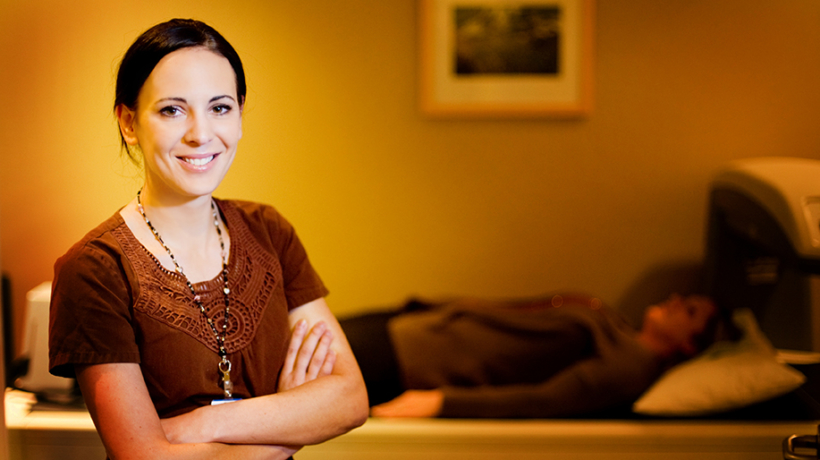DEXA Scans Combat Osteoporosis Through Early Diagnosis at TRA Medical Imaging

The word osteoporosis may evoke images of an older woman with a clearly observable curvature in her spine. That image, however, is misleading. Only the most advanced phase of the bone disease results in such overt symptoms. Until it reaches the latter stages, osteoporosis can be hard to spot and its precursor, low bone density, often goes undetected until someone breaks a bone.
The National Osteoporosis Foundation notes that osteoporosis can sneak up on you. Osteoporosis is often called a silent disease because one can’t feel bones weakening. Breaking a bone is often the first sign of osteoporosis or a patient may notice that he or she is getting shorter or their upper back is curving forward. If you are experiencing height loss or your spine is curving, be sure to consult your doctor or healthcare professional immediately.
Like many other screening exams, patients are encouraged to ask their provider about taking preventative measures and getting a bone density scan. A bone densitometry (DEXA) is an enhanced form of x-ray used to measure bone loss and diagnose osteoporosis – a condition characterized by the deterioration of bone tissue leading to an increased risk of fracture.

“The disease can be difficult or impossible to detect without a bone scan,” says Dr. Geoff Rutledge, a radiologist with TRA-MINW, a medical imaging firm with locations throughout the South Sound. “That’s why DEXA is such a useful test.”
Nationwide, 10 million people are affected by osteoporosis, with an additional 44 million suffering from low bone density. Left untreated, osteoporosis has significant impacts on overall health and quality of life. Compression fractures in the spine can cause chronic pain, while hip fractures can result in disability and even an increased risk of death within a year of the injury. An estimated one in six women who end up in the hospital with a hip fracture do not survive, and the odds are even worse for men.

Bone densitometry (DEXA) is an enhanced form of x-ray used to measure bone loss and diagnose osteoporosis.
DEXA scans are the quickest and easiest way to measure bone health, but many patients know little about the procedure or may have misperceptions about how it’s performed, says Rutledge. “Some people think it’s uncomfortable or invasive, but it’s not,” he explains. “Patients lie on a table and the machine sends very low-dose x-rays at two different energies. It detects how much energy is being absorbed by the bone.” Patients are fully clothed throughout, and the entire process generally takes less than 15 minutes. The exam also requires no preparation such as fasting or avoiding liquids.
Rutledge, who specializes in Musculoskeletal Radiology and Breast Imaging, has also heard concerns about radiation levels, but in fact the doses are extremely low, he assures. “It’s a very small fraction of what you would get in a regular chest x-ray,” Rutledge adds. Typically, radiologists will scan femurs, hips and spine and in cases where hips are not a viable option, forearms.
The scan yields a “T-score,” a number comparing the patient’s bone density to that of an average healthy 30-year-old of the same sex. On the T-score scale, numbers between -1 and -2.5 indicates a loss of bone density, a condition known as osteopenia, while anything beyond -2.5 signals osteoporosis.
The exam also results in a FRAX score through computer software that calculates the risk of fracturing a bone in the future. FRAX scores are based on bone density but also other risk factors such as age, whether someone has had a fracture in the past, if their parents have had a fracture, and if they smoke or have taken steroids. “It calculates the risk of developing a fracture in the next ten years,” explains Rutledge. “We send in a report to the doctor, who then decides whether to initiate treatment.”

The biggest risk factors for osteoporosis are age and gender; around 80 percent of the estimated 10 million Americans with the disease are women. Once women hit age 50, the statistics are startling: one out of every two women over 50 will break a bone because of osteoporosis. While screenings for breast cancer have become routine, many women don’t realize that their risk of breaking a hip due to osteoporosis is higher than their risk of getting breast cancer, uterine cancer, or ovarian cancer combined.
The NOF recommends DEXA screenings for women 65 and over, men 70 and over, women of menopausal age with risk factors, post-menopausal women under 65 with risk factors, men between 50 and 69 with risk factors, and anyone who has broken a bone after age 50. “Being post-menopausal puts you at increased risk,” says Rutledge. “That’s when we typically like to start screening for osteoporosis.”
Patients whose T-scores fall in the -1 to -2.5 category may or may not be advised to begin treatment, says Rutledge. “That’s where the FRAX calculator comes in. If there’s just some bone density loss and no other risk factors, that’s different from someone with other issues.” Lifestyle changes like giving up smoking, eating a healthy diet and getting regular weight-bearing exercise can reverse bone density loss.
Physicians can track how effective the treatment is with another DEXA scan two years later. “It’s a way to screen and track how treatment is working,” says Rutledge. “We don’t see patients getting any taller, but we do see them regain bone density.”
The value of preventing further bone density loss is substantial, both in preventing future injuries and maintaining quality of life. “The most important thing is that this is the best way to detect osteoporosis at an early age before a fracture occurs,” Rutledge maintains. “It’s an easy, non-invasive test that can provide great benefit and prevent complications down the road.”
June 11, 2018 – Heidi Smith
